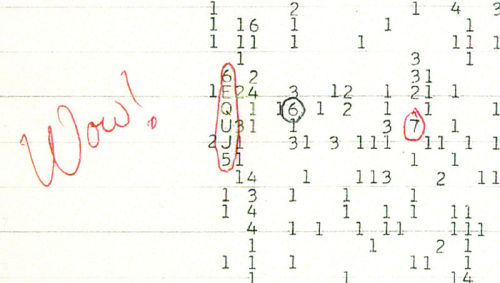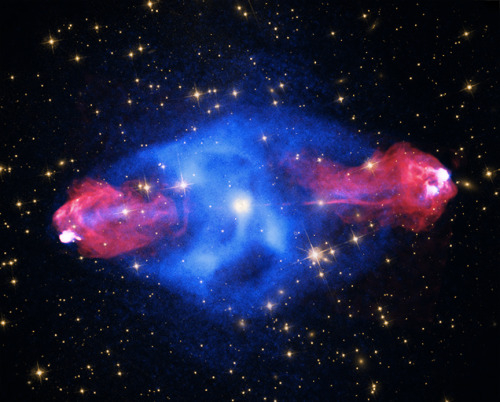The Wow! Signal.

The Wow! signal.
A signal sequence that lasted for 72 seconds in 1977 but has never been seen again. The signal appeared to come from a globular cluster in the Sagittarius constellation, but to this day no definite answer for where the signal originated can be given.
More Posts from Xnzda and Others

Light from Cygnus A: Celebrating astronomy in this International Year of Light, the detailed image reveals spectacular active galaxy Cygnus A in light across the electromagnetic spectrum. Incorporating X-ray data extends to either side along the same axis for nearly 300,000 light-years powered by jets of relativistic particles emanating from the galaxys central supermassive black hole. Hot spots likely mark the ends of the jets impacting surrounding cool, dense material. Confined to yellow hues, optical wavelength data of the galaxy from Hubble and the surrounding field in the Digital Sky Survey complete a remarkable multiwavelength view. via NASA
js
Cosmic rays
Cosmic rays provide one of our few direct samples of matter from outside the solar system. They are high energy particles that move through space at nearly the speed of light. Most cosmic rays are atomic nuclei stripped of their atoms with protons (hydrogen nuclei) being the most abundant type but nuclei of elements as heavy as lead have been measured. Within cosmic-rays however we also find other sub-atomic particles like neutrons electrons and neutrinos.

Since cosmic rays are charged – positively charged protons or nuclei, or negatively charged electrons – their paths through space can be deflected by magnetic fields (except for the highest energy cosmic rays). On their journey to Earth, the magnetic fields of the galaxy, the solar system, and the Earth scramble their flight paths so much that we can no longer know exactly where they came from. That means we have to determine where cosmic rays come from by indirect means.

Because cosmic rays carry electric charge, their direction changes as they travel through magnetic fields. By the time the particles reach us, their paths are completely scrambled, as shown by the blue path. We can’t trace them back to their sources. Light travels to us straight from their sources, as shown by the purple path.

One way we learn about cosmic rays is by studying their composition. What are they made of? What fraction are electrons? protons (often referred to as hydrogen nuclei)? helium nuclei? other nuclei from elements on the periodic table? Measuring the quantity of each different element is relatively easy, since the different charges of each nucleus give very different signatures. Harder to measure, but a better fingerprint, is the isotopic composition (nuclei of the same element but with different numbers of neutrons). To tell the isotopes apart involves, in effect, weighing each atomic nucleus that enters the cosmic ray detector.

All of the natural elements in the periodic table are present in cosmic rays. This includes elements lighter than iron, which are produced in stars, and heavier elements that are produced in violent conditions, such as a supernova at the end of a massive star’s life.

Detailed differences in their abundances can tell us about cosmic ray sources and their trip through the galaxy. About 90% of the cosmic ray nuclei are hydrogen (protons), about 9% are helium (alpha particles), and all of the rest of the elements make up only 1%. Even in this one percent there are very rare elements and isotopes. Elements heavier than iron are significantly more rare in the cosmic-ray flux but measuring them yields critical information to understand the source material and acceleration of cosmic rays.

Even if we can’t trace cosmic rays directly to a source, they can still tell us about cosmic objects. Most galactic cosmic rays are probably accelerated in the blast waves of supernova remnants. The remnants of the explosions – expanding clouds of gas and magnetic field – can last for thousands of years, and this is where cosmic rays are accelerated. Bouncing back and forth in the magnetic field of the remnant randomly lets some of the particles gain energy, and become cosmic rays. Eventually they build up enough speed that the remnant can no longer contain them, and they escape into the galaxy.

Cosmic rays accelerated in supernova remnants can only reach a certain maximum energy, which depends on the size of the acceleration region and the magnetic field strength. However, cosmic rays have been observed at much higher energies than supernova remnants can generate, and where these ultra-high-energies come from is an open big question in astronomy. Perhaps they come from outside the galaxy, from active galactic nuclei, quasars or gamma ray bursts.

Or perhaps they’re the signature of some exotic new physics: superstrings, exotic dark matter, strongly-interacting neutrinos, or topological defects in the very structure of the universe. Questions like these tie cosmic-ray astrophysics to basic particle physics and the fundamental nature of the universe. (source)




Details of the Omega Nebula image credit: European Southern Observatory
Five-dimensional black hole could 'break' general relativity
Cambridge UK (SPX) Feb 19, 2016 Researchers have shown how a bizarrely shaped black hole could cause Einstein’s general theory of relativity, a foundation of modern physics, to break down. However, such an object could only exist in a universe with five or more dimensions. The researchers, from the University of Cambridge and Queen Mary University of London, have successfully simulated a black hole shaped like a very thi Full article
Charting the slow death of the Universe
Paris (SPX) Aug 12, 2015 The study, which is part of the Galaxy And Mass Assembly (GAMA) project, the largest multi-wavelength survey ever put together, involved many of the world’s most powerful telescopes [1]. “We used as many space and ground-based telescopes as we could get our hands on to measure the energy output of over 200 000 galaxies across as broad a wavelength range as possible,” says Simon Driver ICRA Full article

Grand Spiral Galaxy - M 100
Known as a grand design spiral galaxy, M100 is a large galaxy of over 100 billion stars with spiral arms that are like our own Milky Way Galaxy. This Hubble Space Telescope image of M100 was made in 2009 and reveals bright blue star clusters and intricate winding dust lanes which are hallmarks of this class of galaxies. Studies of variable stars in M100 have played an important role in determining the size and age of the Universe.
Credit: NASA/APOD
-
 servungcint reblogged this · 3 weeks ago
servungcint reblogged this · 3 weeks ago -
 ohhoneyhoneyy reblogged this · 1 month ago
ohhoneyhoneyy reblogged this · 1 month ago -
 faeline liked this · 1 month ago
faeline liked this · 1 month ago -
 suppuration reblogged this · 4 months ago
suppuration reblogged this · 4 months ago -
 catsinspacesuits liked this · 4 months ago
catsinspacesuits liked this · 4 months ago -
 layziethelapras liked this · 5 months ago
layziethelapras liked this · 5 months ago -
 flairina reblogged this · 5 months ago
flairina reblogged this · 5 months ago -
 wretchie liked this · 6 months ago
wretchie liked this · 6 months ago -
 artoklasia reblogged this · 6 months ago
artoklasia reblogged this · 6 months ago -
 itsgonnabeasparklingday liked this · 8 months ago
itsgonnabeasparklingday liked this · 8 months ago -
 all-the-beautiful-chaos liked this · 8 months ago
all-the-beautiful-chaos liked this · 8 months ago -
 thepillarsofmarsandvenus liked this · 8 months ago
thepillarsofmarsandvenus liked this · 8 months ago -
 exaltedrevenge liked this · 9 months ago
exaltedrevenge liked this · 9 months ago -
 parttimepunner reblogged this · 9 months ago
parttimepunner reblogged this · 9 months ago -
 parttimepunner liked this · 9 months ago
parttimepunner liked this · 9 months ago -
 moss-sauce liked this · 10 months ago
moss-sauce liked this · 10 months ago -
 alwaysacurious1 liked this · 10 months ago
alwaysacurious1 liked this · 10 months ago -
 alice-quinn-at-oxford reblogged this · 10 months ago
alice-quinn-at-oxford reblogged this · 10 months ago -
 muigi1 liked this · 10 months ago
muigi1 liked this · 10 months ago -
 rabbitheads liked this · 11 months ago
rabbitheads liked this · 11 months ago -
 meissama liked this · 1 year ago
meissama liked this · 1 year ago -
 warcotuj8746 liked this · 1 year ago
warcotuj8746 liked this · 1 year ago -
 depressedgaylaughter reblogged this · 1 year ago
depressedgaylaughter reblogged this · 1 year ago -
 chaotically-gay reblogged this · 1 year ago
chaotically-gay reblogged this · 1 year ago -
 derecho-noah reblogged this · 1 year ago
derecho-noah reblogged this · 1 year ago -
 cherryboness liked this · 1 year ago
cherryboness liked this · 1 year ago -
 blueeyedjoy reblogged this · 1 year ago
blueeyedjoy reblogged this · 1 year ago -
 bluefrost-freewolf liked this · 1 year ago
bluefrost-freewolf liked this · 1 year ago -
 sythesizeher reblogged this · 1 year ago
sythesizeher reblogged this · 1 year ago -
 sythesizeher liked this · 1 year ago
sythesizeher liked this · 1 year ago -
 internetfriendsforever reblogged this · 1 year ago
internetfriendsforever reblogged this · 1 year ago -
 internetfriendsforever liked this · 1 year ago
internetfriendsforever liked this · 1 year ago -
 lostbetweenthenotes reblogged this · 1 year ago
lostbetweenthenotes reblogged this · 1 year ago -
 whatthelaughman reblogged this · 1 year ago
whatthelaughman reblogged this · 1 year ago -
 angelictroublemaker liked this · 1 year ago
angelictroublemaker liked this · 1 year ago -
 redredredcake liked this · 1 year ago
redredredcake liked this · 1 year ago -
 janokenmun reblogged this · 1 year ago
janokenmun reblogged this · 1 year ago -
 confused-and-slightly-disturbed liked this · 1 year ago
confused-and-slightly-disturbed liked this · 1 year ago -
 janokenmun liked this · 1 year ago
janokenmun liked this · 1 year ago -
 annalies liked this · 1 year ago
annalies liked this · 1 year ago -
 lichfucker liked this · 1 year ago
lichfucker liked this · 1 year ago


